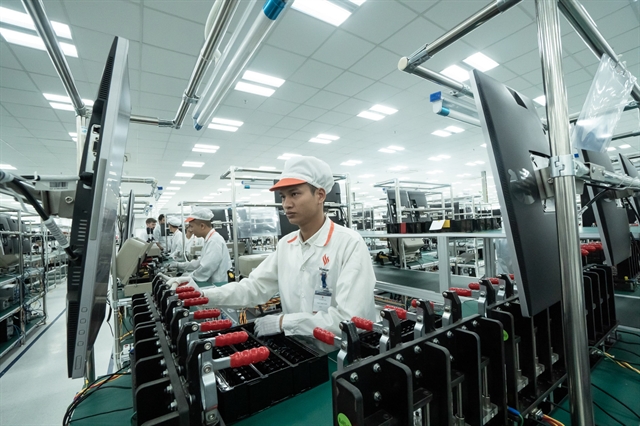 Economy
Economy


|
| Smartphones are produced at a Vingroup factory in Hải Phòng. Photo: quandoinhandan |
Compiled by Thiên Lý
At the start of the year a report in the Korea Times newspaper said Vingroup is likely to acquire LG’s smartphone manufacturing plants in Việt Nam, China and Brazil.
Vingroup, one of Việt Nam’s biggest conglomerates, was seeking to expand into the high-tech sector through the acquisition of the state-of-the-art facilities, improve its global smartphone competitiveness and use the Brazilian and Chinese plants to enter regional markets.
But it later reported that the talks were off after Vingroup reportedly asked for too low a price.
Nevertheless, it indicated it could be a busy year for mergers and acquisitions (M&A) in Việt Nam, especially in technology.
The pressure to fast-track digital transformation has persuaded many Vietnamese companies like Vingroup to opt for acquisition of foreign companies instead of building technologies from the ground up.
In June last year Prime Minister Nguyễn Xuân Phúc approved the national digital transformation programme for up to 2025.
Deputy Minister of Information and Communications Nguyễn Huy Dũng, speaking at a conference last December, called on enterprises to speed up digital transformation, saying it was essential for business growth.
He urged every organisation to outline strategic plans to implement and speed up digital transformation, saying Vietnamese digital technology companies would be the key players in developing digital infrastructure, platforms, services, and solutions, mastering core technologies and extending global reach.
Trần Thọ Đạt, chairman of the National Economics University, said the digital economy was important to the economy’s productivity and efficiency in the coming years and a motivation for rapid improvement in labour productivity.
It is necessary to encourage digitisation in every sector like manufacturing, ICT, science and technology, finance, banking, insurance, and real estate, he said.
Hoàng Việt Anh, deputy general director of FPT in charge of digital transformation, said digitisation would continue to be an important trend even after the COVID-19 pandemic ends.
“During the toughest and most challenging times, technology is the key to opening up opportunities for growth, optimising operations, improving customer experience, and creating new business models.”
In the current changed circumstances, digital transformation would have a bigger effect, enabling enterprises to play a critical role in shaping new realities, he said.
Việt Nam’s IT industry has seen significant growth in recent years, and helped enhance the country’s competitiveness.
Ministry of Information and Communications statistics show that the industry’s revenue in 2019 were an estimated US$100 billion, equivalent to a third of the country’s GDP, and employed around one million people.
Việt Nam’s digital economy is projected to be worth $43 billion by 2025, with the fastest growth coming in e-commerce, online travel, online media, and ride hailing, according to a report by Google and Temasek.
More than 3,000 enterprises have sought the Government’s support for digital transformation since December alone, showing that Vietnamese businesses are keen on catching up with global trends.
Deputy Minister of Planning and Investment Trần Duy Đông said digital transformation is of vital importance to businesses globally, including in Việt Nam.
The COVID-19 pandemic has forced enterprises around the world to assign top priority to this to survive.
To achieve this, M&A are considered the quickest route since they would enable enterprises to overcome their technological disadvantages like the shortage of infrastructure and human resources.
Analysts said low interest rates, increasing demand for development of creative business activities using technology and digital techniques and digital technology buyers with deep pockets are expected to spur the M&A market.
Auto sector remains firmly on growth path
The Vietnamese auto market is expected to remain strong despite the effects of the COVID-19 pandemic.
Analysts listed several reasons for this, including the fact that incomes is expected to rise by 8-10 per cent annually for the next 10 years.
In a report before Tết (Lunar New Year) holiday SSI Securities Corporation said car demand would continue to rise since taxes and fees have been lowered in many segments.
In the first half of 2020, after the pandemic began, auto sales fell by 31 per cent year on year.
The Government acted quickly and cut registration fees for locally made cars by 50 per cent.
Car production has grown rapidly, sparking fierce competition both among local assemblers and with imports, helping bring down prices.
With many more assembly and parts manufacturing plants set to open in the country in 2022 and 2023, the auto market is expected to become even more competitive, and carmakers would have to come up with more promotions to retain market share in the face of a likely onslaught from newcomers.
Another important reason is that the Vietnamese market has become large enough to encourage carmakers to shift from importing vehicles to making them here.
Currently six companies account for 90 per cent of the market. The six, Thaco, Hyundai, Toyota, Mitsubishi, Ford, and Honda, have a production capacity of 30,000-40,000 units a year each.
Four of them have announced investments in major car plants in the last two years.
Experts also warn of likely risks the auto sector faces.
The first related to the environment. With its goal of reducing pollution, the Government has taken a number of measures to restrict the use of personal vehicles in large cities.
Next is policy or regulatory risk to the investment environment caused by unexpected changes to government regulations and policies.
The legal framework for the automobile industry has been changed constantly in line with revised laws and regulations especially to favour domestic players though they sometimes contradict provisions of free trade agreements Việt Nam has signed.
Due to this, some automakers have been cautious about investment in the country.
Last but not least is the lack of supporting industries for the auto industry, which means manufacturers have to depend on imports for components. VNS




